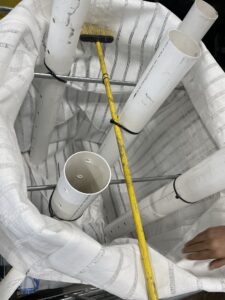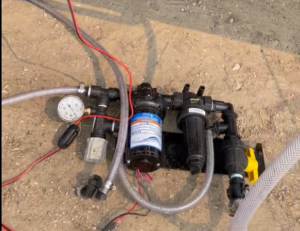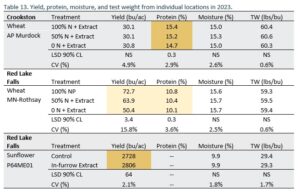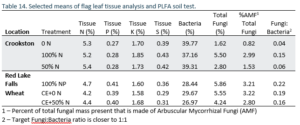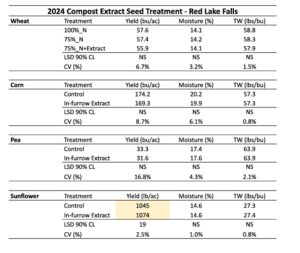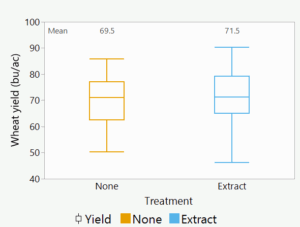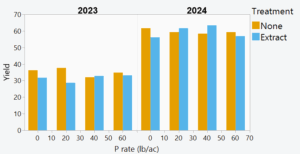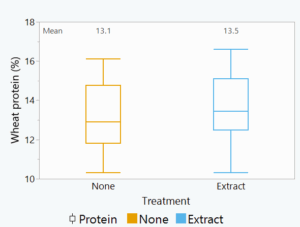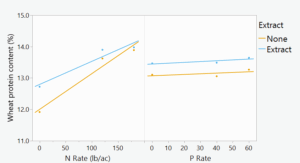Final report for ONC23-119
Project Information
High yielding wheat and soybean crops require high amounts of applied N and P fertilizer. We will determine if fertilizer rates can be reduced by using furrow-applied Johonson-Su bioreactor compost extract. We hypothesize that this extract will inoculate the soil with beneficial microorganisms to work symbiotically with crop roots to supply additional soil nutrients that are inaccessible by the crop. This could immediately benefit farmers by reducing their fertilizer needs and improving the health and biological activity of their soil. Reducing fertilizer use while maintaining farm profitability is a huge hurdle that must be overcome as industrial agriculture moves towards more environmentally sustainable methods of production. We will test the compost extract at scale with our cooperating farmers to determine if this homemade biological inoculant is economically profitable and can reduce fertilizer needs. We will also conduct small plot trials to assess the effect of compost extract inoculation with varying levels of fertilizer to determine the optimum amount of fertilizer needed with and without compost extract. We will share these results in various grower meetings and printed and electronic publications hosted by both the MN Wheat Council and the UMN to reach producers in MN, ND, SD, and eastern MT.
At the conclusion of this research, we aim to:
- Demonstrate methods to economically create and use a Johnson-Su Bioreactor on a commercial crop farm to wheat and soybean
- Determine if N and P fertilizer can be reduced by using compost extract applied in-furrow at planting
- Evaluate fungal and bacterial species diversity and quantity in compost extract
- Educate regenerative and conventional farmers about the principles and methods behind the compost extract application to wheat and soybean and how to replicate the process on their own farm
Cooperators
- - Technical Advisor (Researcher)
Research
Bioreactors
- 4 Bioreactors were built by hanging bulk seed tote bags inside the cages of bulk shuttle totes, and hanging 5 perforated sewer pipes inside the tote to serve as the air chimneys. The bottom 6-8 inches of the inner plastic bladder were cut out and placed back inside the cage to catch any excess leachate from potentially overwatering the bioreactor. Pallets were cut to fit inside the cages and placed inside the plastic liner, below the tote bags to allow extra water to drain out of the tote bag and into the cut out bottom of the plastic bladder, which could be drained using the shuttle tote's ball valve if too much liquid accumulated
- Compost materials included a mix of approximately 50% rye straw chopped with a bale processor, 10% partially decomposed wood chips, 10% mulched oak leaves, and 20% horse manure mixed with hay. The manure was free of dewormer, and the straw was free of chemical residues.
- Materials were mixed together in a wheel barrow, then transferred to laundry baskets and submerged in water until they were sufficiently soaked, drained for a few minutes and then distributed around the chimneys inside each of the bioreactors
- An automatic sprinkling system was setup using garden irrigation drip line and an automatic timer for garden hoses to keep the compost moist. Bioreactor compost was also partially covered using scrap pieces of landscape fabric to reduce evaporation.
- The bioreactors went through their heating cycle over the course of the first week and peaked at about 130 F
- After the bioreactor internal temperature dropped back down below 80F, approximately 2 lbs of red composting worms were added to each bioreactor.
- Bioreactors were maintained in heated shops above 60F throughout the remainder of the year, adding water as necessary to maintain moisture so that the compost wasn't overly drenched, but a handful of compost squeezed in the hand could squeeze out a drop of water
Extraction and Application
- Fed N Happy worm castings were used in place of Johnson-Su compost in the 2023 growing season, since we did not have access to suitable Johnson-Su compost for the first year. We went with worm castings since the Johnson-Su process with worms essentially results in matured vermicompost, and Fed N Happy's method of raising worms would result in a similar product suitable for comparison. A BeCrop DNA analysis of the worm castings revealed about 848 species of bacteria and 137 species of fungi present in the castings.
- In 2024, compost extract from the Johnson-Su compost created in 2023 was used on-farm and in small plots. A RhizeBio DNA analysis of Johnson-Su compost revealed about 6000 species of bacteria/archaea and 60 fungal organisms present in the four bioreactor containers.
- Extract was initially made for the small plot research and the wheat seed treatments by vigorously bubbling 2 lbs of material (worm castings or compost)/gal in a 5 gal bucket using a circular lawn sprinkler attached to an air compressor at approximately 15-20 psi for at least 30 min. The extract was filtered first through a 5 gal paint filter, and then through a finer cone paint filter (micron/mesh size unknown). The extract for the on-farm field plots was additionally run through a system of T-line filters attached to a small sprayer pump set up by one of our cooperating farmers fitted with a 30 mesh and a 50 mesh filter.
- Wheat seed was treated by spraying the filtered extract onto the wheat seed as it was being augered from a truck to the seed tender/gravity box at a rate of 9 0z/cwt, which is a similar volume rate for commercial seed treatments. Wheat seeds were covered and thouroughly mixed by augering, but were not so wet as to cause bridging or clogging problems. A 60 gal mixing cone held the extract and was attached to the T-line filter/pump sprayer set up with a fine nozzle tip.
- An additional sunflower plot used a liquid in-furrow drip application at planting instead of a seed treatment. For this extraction, we used 1/3 lb compost/gal, applied at a rate of 6 gal/acre to reach a the rate of 2 lbs compost applied/acre suggested by David Johnson. Compost was again first bubbled inside a 5 gal paint filter hung inside a 60 gal mixing cone. A trash sump pump was also hung inside the mixing cone with a 1.5 inch hose attached, which was used to circulate and agitate the water and compost during the extraction. The initial extract was run through the T-line filtration set up and filtered down to 50 mesh before being transferred to the air seeder's rinsed starter fertilizer tank

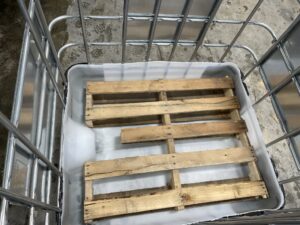
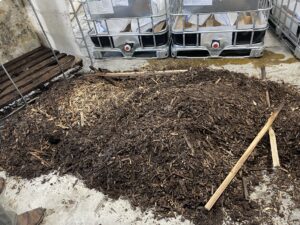
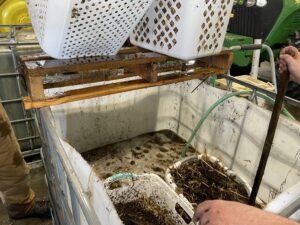

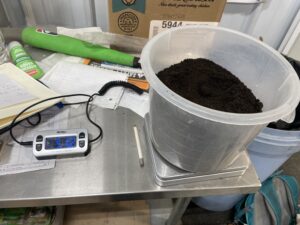
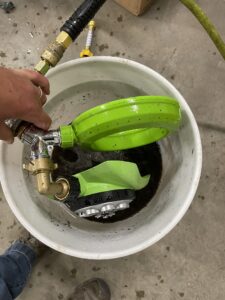
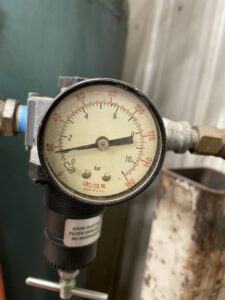
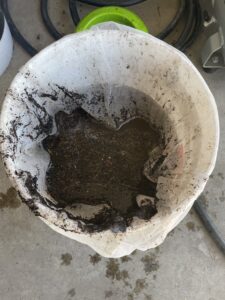
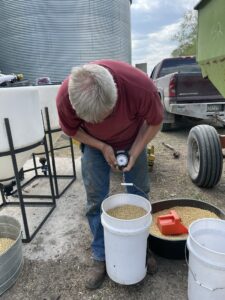


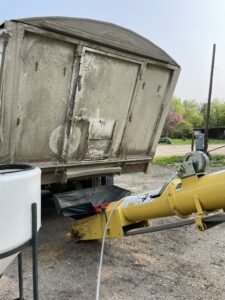
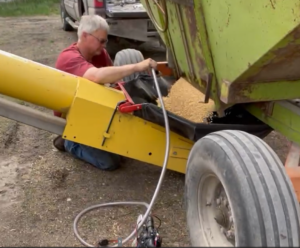
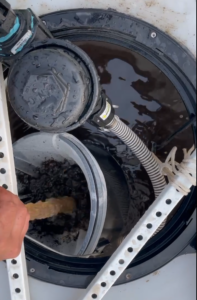
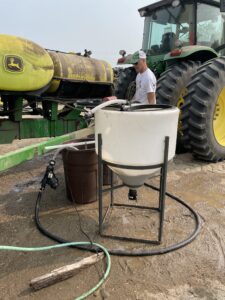
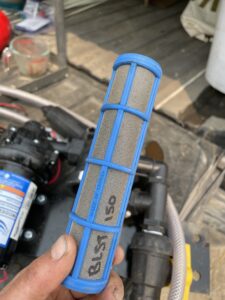

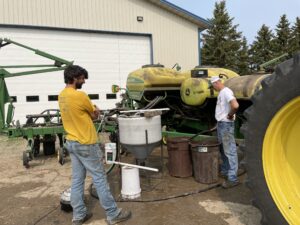
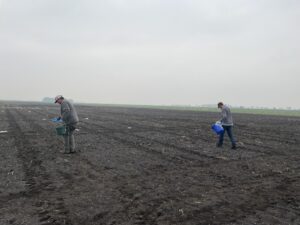
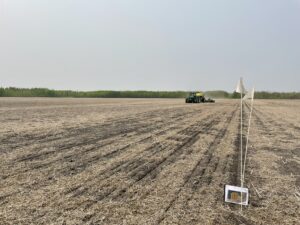
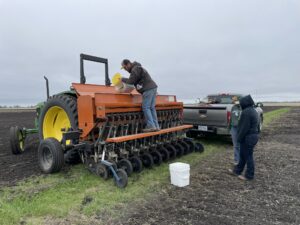
On-Farm Plots
- At planting, wheat plots were fertilized with their respective fertilizer treatments using a pull-type spreader or the coop's spreader. The Johnson-Su treated plots were planted first with the treated seed, and then the untreated plots were filled in afterwards with regular untreated seed.
- The other crop plots (sunflower, corn, pea) planted normally and without any fertilizer treatments, just turning the liquid system on and off through the respective treated and control plots as the field was planted.
- All plots were flagged and marked with GPS at planting
- Tissue samples were collected at late boot/early flag leaf stage in the wheat sites
- Plots were harvested with the grower's combine and weighed in a weigh wagon. Grain samples were collected to test moisture, test weight, and protein content.
- Soil samples were collected after harvest for nutrient analysis and PLFA testing
- Treatments were applied as follows:
2023
- Control – Farmer fertilizer rate, no extract
- Compost extract + ½ N rate + 0 P
- Compost extract + 0N + 0P
2024
- Control - 100% N rate
- Control - 75% N rate
- 75% N rate + compost extract
Small Plots
- Wheat and soybean small plots were set up as randomized split-plots, with the extract as the main plot and fertilizer treatments as the sub-plots. The wheat plot was replicated 3 times, and the soybean plot was replicated 4 times as field space allowed.
- Wheat seed was treated with extract while the soybean plots received an in-furrow application. The extract was made by bubbling in a 5 gal bucket as described above, following the compost and application rates as described above for either the seed treatments in the wheat or the in-furrow rate for the soybean plot.
- Tissue tests were collected at late boot in wheat and 3rd trifoliate in soybean
- Plots were harvested with a small plot combine by the U of MN Crookston plot technicians. Grain samples were collected to test moisture, test weight, and protein content.
- Soil samples were collected after harvest for nutrient and PLFA analysis
- Treatments were applied as follows:
- 0, 120, 180 lbs N; with compost extract (wheat only)
- 0, 120, 180 lbs N; no compost extract (wheat only)
- 0, 40, 60 lbs P2O5; with compost extract (wheat and soybeans)
- 0, 40, 60 lbs P2O5; no compost extract (wheat and soybeans)
SARE - Year 1 Johnson-Su Bioreactor in Wheat, Soybeans, and Sunflower Preliminary Results2023 OFR Report
2023 On-Farm Yield Data
In this first season, differences in N rate treatments were too great to measure any potential biological response. In the second year, we modified the fertilizer treatments to be 100% N Control, 75% N Control, and 75% N + Johnson-Su Extract.
There was a small but significant yield increase with the in-furrow application in sunflowers in both years, but not in the treated wheat seed or with the in-furrow corn and pea applications.
SARE - Year 1 Johnson-Su Bioreactor in Wheat, Soybeans, and Sunflower Preliminary Results
2024 On-farm Yield Data
UMN Small Plot Trials
Small plot results: Spring Wheat
Across the two years of the trial, mean wheat yield was 2 bu/ac greater with extract applied than without. This difference was statistically significant (p<0.05; figure R1). Notably, wheat yields did not show a strong, consistent response to nitrogen and phosphorus fertility treatments (p>0.05). This may be due to the highest levels of N fertilization (180 lb N/ac) having a negative effect on wheat yield.
Wheat protein content was significantly greater with extract than without (p<0.05) (figure R2). Protein content showed a significant positive response to N fertilization, but not to P fertilization (figure R3). The effect of extract on protein content was greater when no nitrogen fertilizer was applied than when 100 or 150 lb of nitrogen was applied. Phosphorus fertilization did not significantly affect protein content.
Small plot results: Soybean
We did not see a significant effect of extract or phosphorus fertilization on soybean yield in 2023 or 2024 (p>0.1, Figure R4). One potential reason for a lack of yield response could be due to soybean crops being able to access enough P from the soil. UMN fertility trials have found that soybeans only respond to P fertilizer application about 50% of the time even when soils are phosphorus limited. This is because other factors, such as a lack of rainfall, can greatly affect soybean yield.
Educational & Outreach Activities
Participation Summary:
7-18-23 - Presented to approximately 20 farmers, industry reps, and researchers during a field tour of the small plot research portion of this project hosted for the MN Wheat Research and Promotion Council's Wheat Research Committee.
12-13-23 - Presented on-farm yield, tissue test, and soil test results to approximately 75 growers and industry reps during the 11th annual On-farm Research Summit at the Prairie Grains Conference in Grand Forks, ND. The participating farmers were also in attendance to answer questions as needed. The recording video recording is posted on MN Wheat's YouTube channel at https://www.youtube.com/watch?v=XPOS1E4vO2Q&list=PLD9ujiJyhaYcd1ur6bo2wA5UQQJKpsMA2&index=2.
12-13-23 - Printed copies of our On-farm Research Report containing our preliminary 2023 trial results were passed out to each grower at the On-farm Research Summit.
1-9-24 - 1-12-24 Presented a condensed version of the on-farm trial results to approximately 237 growers and industry reps during MN Wheat's Small Grains Updates Meetings, a series of grower meetings in NW MN held in Dilworth, Crookston, Ada, Hallock, Roseau, and St. Hilaire, MN, over the course of 4 days. The printed on-farm research reports containing the project results were also passed out to each attendee.
6-11-24 - NWROC Researcher Heidi Reitmeier presented a poster on the construction and extraction of Johnson-Su composters at the Soil Science Society of America annual meeting in San Juan, Puerto Rico. We were also able to share initial results from on-farm and small plot trials. Attendees learned the benefits and challenges of constructing the composters with local materials and applying this low-cost technology on-farm.
7-9-24 - One of our on-farm cooperators showcased the Johnson-Su composter to about 60 farmers during a Soil Health Field Day event in Crookston, MN. Originally, the event would have been on his farm, but due to rain the week of the event it was hosted at the Northwest Research & Outreach Center. We had one of the composters out during the field day for growers to look at and a handout on preliminary trial results to share.
Learning Outcomes
Project Outcomes
This project has helped the local farmer cooperators to apply and test compost/vermicast extract at field scale on their own farms, and has allowed us to share the story of the process and how to do it with other growers in the area who have been interested and asked questions. The results have also shown that there is a lot more to be figured out with methods, application rates, and crop fertility, and that the extract is not a silver bullet to reducing fertilizer requirements, but will take some further finessing to figure out when, where, and how the applications will benefit crop production and soil health.
Beef and Wheat/Soybean/Corn/Sunflower/Pea farmer cooperator, Red Lake Falls, MN - [We] had made a bioreactor in a previous year, but didn't really know how to, or dedicate the resources to applying it in order to test it. We also didn't test the biology present in the bioreactor we had, so didn't have confidence anything was there, or if there was any bad biology in the compost. Making the compost was labor-intensive, but determining how to use and apply the compost extract was a skill that was daunting for us without the help this grant provided.
The small yield increases in the sunflower on-farm plots and the wheat small-plots indicate there is some merit to applying DIY biological extract to crops to boost productivity, however the small increases are not currently economical on a commercial scale. Long-term, repeated experiments applying the compost extract to the same plots each year are needed to monitor changes over time. Further exploration of the differences in soil biology between the treatment and control by a soil biologist would bring further insight into the microbiome dynamics occurring in the rhizosphere.
Farmer cooperator recommendations/comments -
- There is a need for good screens and nozzles.
- We are able to put down a lot more compost product in furrow than with seed treatment.
- Seeing the impact the worms made in the bioreactors has been impressive.
